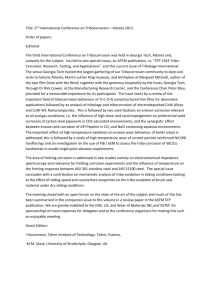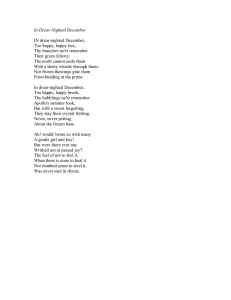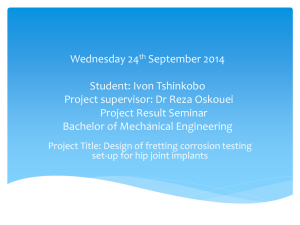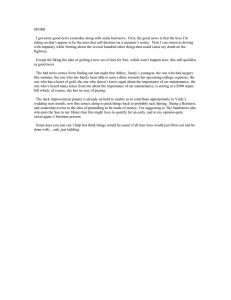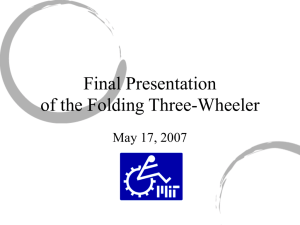Impact of corrosion on fretting damage of electrical contacts
advertisement
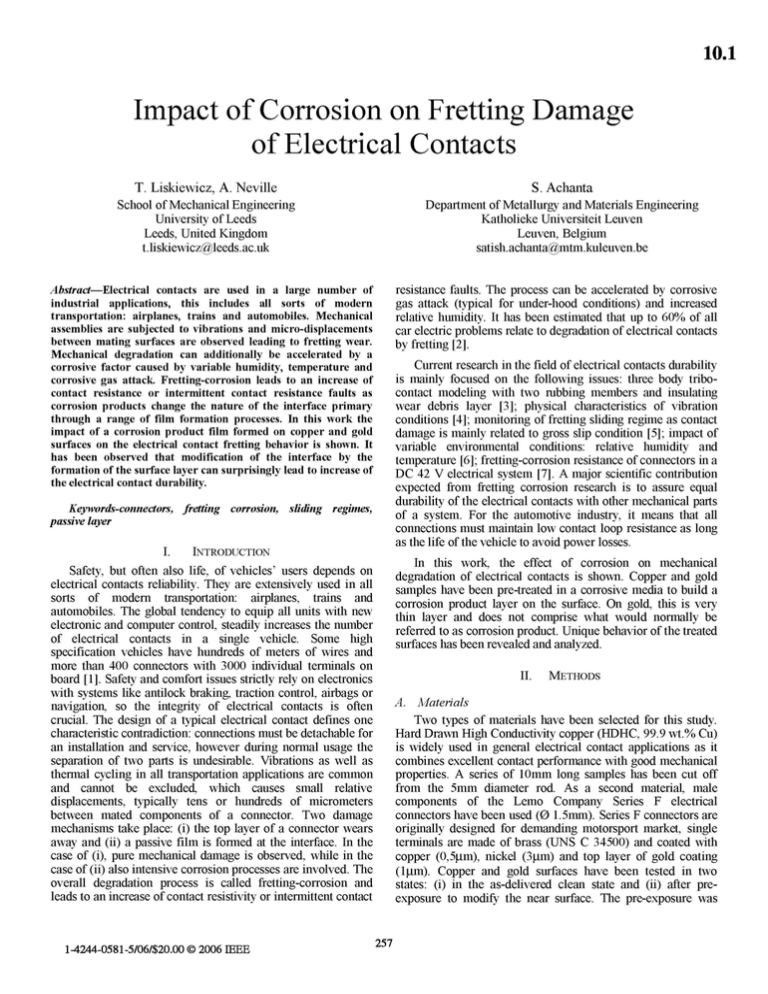
Impact of Corrosion on Fretting Damage of Electrical Contacts T. Liskiewicz, A. Neville S. Achanta Schml of Mechanical Engneering University of Leeds Leeds, United Kingdom Department of Metallurgy and Materials Engneering Katholieke Universiteit Leuven Leuven, Belgium t.liskiewic~@,leeds.ac.uk satish.achanta@~m.kuleuven.be Abb~ad-Electrical contacts are used in a large numher of industrial applications, this includes all swts of modern transportation: airplanes, trains and automobiles. Mechanical assemblies are subjected to vibrations and micro-displacements betwen mating surfilces are observed leading to fretting wear. Mechanical degradation can additionally bc acceletrltcd hy a cnrrosive factor caused hy variable humidity, temperature and corrosive gas attack Fretting-corrosion leads to an increase of contact resistance or inkrmittent contact resistance faults as corrosion products change the nature of the interface primary through a range of film formation processes. In this work the impact of a cnrrosion product film formed on copper and gold surfaces on the electrical contact fretting behavior is shown. It has been observed that modification of the interface by the formation of the surface layer can surprisingly lead to increase of the elcctrical contact durability. Kepw&-connecfm, f m h g corrosion, slidittg r e g h a , pmsi1s layer Safety, but often also life, of vehicles' users depends on electrical contacts reliability. They are extensively used in all sorts of modern transportation: airplanes, trains and automobiles. The global tendency to equip all units with new electronic and computer control, steadily increases the number of electrical contacts in a singlc vehiclc. Some high specification vehiclcs have hundrods of meters of wires and more than 400 connectors with ROO0 idvidual terminals on board [ 11. Safety and comfort issucs strictly rely on electronics with systems like antilock braking, mction control, airbags or navigatig so the integrity of electrical contacts is otten crucial. The design of a typical electrical contact defines one chamcteristic conlrahction: connections must bc detachable for an installation and service, however during normal usage the separation of two parts is undesimble. Vibmtions as well as thcrmal cycling in all transportation applications are common and cannot be excluded, which causes small relative displacements, typically tms or hundreds of micrometers Mween mated components of a conncctor. Two damage mechanisms take placc: (i) the top Iaycr of a connector w a r s away and (ii) a passive film is formed at the interface. In the case of (i), pure mechanid damage is observed, while in the case of (ii) also intensive corrosion p r m s e s arc involved. The overall degradation process is called fretting-corrosion and leads to an increase of contact resislivity or intcrmittent contact resistance faults. The p r m s s can be accelerated by corrosive gas attack (typical for under-hood conhtions) and increased relative humihty. It has been estimated that up to 60% of all car electric problems relate to degradation of elcctrical contacts by fretting 121. Current research in the field of electrical contacts durability is mainly focused on the following issues: three body tribocontact modeling with two rubbing members and insulating wear debris laycr [3]; physical clmcteristics of vibration condrtions [4]; monitoring of fretting slidmg regime as contact damage is mainly related to gross slip condition [51; impact of variable environmental conhtions: relative humihty and temperature [il; frettingarrosion resistancc of connect m in a DC 42 V electrical system [7]. A major scienhfic contribution expected from fretting corrosion rescarch is to assure equal durability of the electrical contacts with other mechatucal parts of a system. For the automotive industry, it means that all c o n n d o n s must maintain low contact loop resistance as long as the life of the vehicle to avoid power losses. In this work, the effect of corrosion on mechanical degradation of electrical contacts is shown. Copper and gold samplcs have been pre-treated in a corrosive mcdia to build a corrosion product layer on the swface. On gold, this is very thin layer and does not compse what would normally be referred to as corrosion product. Unique behavior of the treated swfaccs has been revealcd and analy7ed. A. Materials Two types of materials have been selected for this study. Hard Drawn High Coducfivity copper (HDHC, 99.9 wt.% Cu) is widely used in gencml electrical contact applications as it cornbincs excellent contact performance with good mechanical properties. A series of lOmm long samples IMS been cut off from the 5mm diameter rod As a m n d material, male components of the Lemo Company Series F electrial connectors have bccn used (0 1.5mm). Serics F cmectors are originally dcsigned for demanding motorsport market, single terminals are madc of brass (UNS C 34500) and m t e d uilh copper (0,5pm), nickel ( 3 ~ and ) top layer of gold coating (lpm).Copper and gold surfaces h v e tteen tested in two states: (i) in the asdclivered clean state and (ii) after preexposure to modify thc near d a c e . The pre-exposure was conducted by immersion of samples in sea waker (3.5% wt. NaCl) three l h e s for 24 hours with 24 hour intemls in air. gross slip regime: with still higher displacement amplitude, the stick zone no longer accurs and the entire contact area is subjected to sliding In this B. Test conJiguraiion Frening e q d m e n t s have been carried out using the MUST tester madamred by FaIex [8]. A reciprodng sliding between samples arranged in crossed cylinders geomelq has been applied (Fig. I). The test program has k e n carried out under 0.5N and 1N normal load (N), 10p-nto 2 5 p displacement amplitude (6), and at the 1.2Hz to 2 . m frequency (f). The normd load has been kept constant, while the friction force (Q)and displacement amplitude have been recorded Tests have been concluded in a room environment at the 20-22°C temperature and 45-50% relative humidity. The four-wire rnemnmmt technique has been applied as a particuIarly a m t e way to measure small ~sistances.The value of 500mQ has k e n a m e d as a representative limit of electrical resimce for d d d contacts used in the automotive industry 191. regune, the wear mechanism takes pIace by debris formation (by creating and breaking the adhesive junctions). The debris can aIso remain within the contact area as abrasive particles. The maxrmal tangential force does not depend upon the sliding amplitude and can be described by the cIassic Amonton's fiiction law:Q=@. The evolution of the fie* log in this regime takes more quadratic shape (Fig. 2c). The above approach was then develo@ [ll] by defining three frethg regimes for the rum& conditions recorded during the frethg test and the Rurlning Condition F h g Map was proposed Fig. 3): partial slip regime PSR) corresponding to the COndifioII when stick-dip sliding regime is maintained during tlx mming test, observed for the smallest amplitudes; C. Sliding conditiom underfreiYing gross slip regme (GSR) correspondug to the condition Different damage mechanisms involved in kdhg are W e d to the sliding conditions at the h r h c e and the following fretthg regimes were distinguished [lo]: stick regime: the interfacial sliding between two badies does not occur as displacement is accommodated by elastic deformatim The stick domain is maintained by locked asperities that can be plastically shared in the direction of micro-movement Low kmg Mgue damage can originate mainly by crack nucleation and pmpagation. For this regime, the evolution Q=f(S), called hliing log, takes form of closed linear relabon pig. 2a); stick-slip regime: even though sliding does mu, the stick zone is a dominating area in the contact. S d c e degradation is characterized by cracldng as a result of contact fatigue pticularIy dose to the stick-slip boundary. If rough surfaces are subjected to contact, the stick zone can be spread for a number af single contacts. The Q S curve takes a h c t e r i s t i c elliptml shape hysteresis (Fig. 2b); - Figure 1. Schematic of cxpwimental &thg assembly. when gross slip sliding regime is maintained cturing rznming test, o b w e d for the largest amplitudes; r mixed fieregime (MFR) corresponding to the wmhtim when the gross shp and paaial slip regimes are present in one £retlmg test, observed for intermediate amplitudes. Evolution of the contact resistance as a function of fretting time for d8erat loading condition& materials, with and without the pre-cqmsure surface Iayer is depicted in Fig. 4. Because of space lirnihtiong only selected sets of data are presented here. For each eqmiment, representative shapes of the fretting loops from the beghung and end of the test are included to indicate the Wtmg regme of the tribcouple. The first raw of graphs (Fig. 4a-c) gives results for oopper/copper contact with clean s d w s and all three expimenis are maimhed within the gross slip fretting regime. It is shown that increase of normal load h m 0.5N to 1N (under qual displacement amplitude) is related to the w of eI&cal contact durability. At the mme time, an hcmx of displacementamplitude from 1 5 p to 2 5 p (under equd n d load), sigdcantly decmsed the durability of the contact Figure 2. Fretting log charactm-idcsfor different htting regimes: (a) stick regime; (b) dck-slip regime, (c) p s slip regime. The second row of graphs (Fig. 4d-f) psents contact resistanoe curve6 for the same l d q conditions as discussed above, however with the passive layer h e d on the wppr mples' d c e . It can be seen that m&c$tion of the herface caused both extended durability of the comets and passage (in two cases) h m the gross dip to partial slip k t h g regime. It is interesting that after initial high resistancedated to the presence of the passive fi followed by low resistance of the c o n k t after passive film removal, chamteristic W e of the contactresistanceis not observed. Fipre 3. Rurming Condition Fretting Map Ill]. - CulCu, 0.5N, 15pm clean surface - CulCu, IN, 15pm clean surface - I 0 4000 fretting time [s] 2000 I 6000 fretting time [s] 3000 9000 fretting time [s] -- I I I fretting time [s] 6000 CdCu, I N , 25pm passive layer 9000 3000 fretting time [s] - I 6000 CulCu, 1N, 16pm passive l a y r 3000 CulCu, 1N, 25pm clean surface 6000 9000 fretting time [s] - Au/Au, 0,5N, 25pm clean surface - AulAu, 1N, 25pm clean surhce - D+u /+/ Y . .I I I 10000 20000 fretting time [s] I 0 0 I I I 10000 20000 30000 fretting time [s] 0 0 I0000 20000 30000 fretting time [s] Figure 4. Evolution ofthe contact resistauce u a function of W i n g time with the M i g loops correspondingto the beginning and the end of a c h test. The last row of graphs (Fig. 4g-i) depicts data for gold/gold fretting contact with clean and passivated s d c e . In tlut case. in spite of much longer test durations, building of the passive layer does not take place independently of the loading conditions and state of tlie sample surface. Increase of normal load from O.5N to 1N (under equal displacement amplitude) from gross slip to parhal slip fretting regme. caused a It has baen observed that presence of the passive layer was conducive to the hgher coefficient of hction (COF)values. Cornpanson of mean COF for several fretihg tests on clean surfaces and mted with the pssive layer is shown in Fig. 5. Generally the gold/gold interface is characterized by higher friction. It can also be n o t i d that in the case of copper, an increase of displacement amplitude is related to higher COF values. IV. Drscussro~ A. Fretting conract exposure surface Bibliogmphical sources quote Merent values of displacement amplitudes as a border betwecn fktting and reciprwating slidmg motion. Thls value is variously interpreted and contained w i t h a wide range of amplitudes between 50 and 3 0 0 p [12-141. Thls issue can be clantied by introducing the "e" M i c i e n t [15], whicl~is d e h e d as a sliding ratio: where: 6- sliding amplitude, which is Merent fiom the &splacement amplitude due to tlie contact and testing dmdevlce compliance; a - H h a n contact rahus. The tribo-system remains in the fretting regime ( 6 1 ) when the unexposed surface is maintained at the centre of the fretted surface. The system gms into the reciprocating slidmg regime SLTDING RATIO FOR CU/CU CONTACT m um PASSWE LAYER. SIidir~gratio e Displacement amplitude Q ~ I ) P-0.SN P-lN 10 0.43 0.34 IS 0.65 0.52 20 0.87 0.69 25 1.09 0.86 (e>1) when all the surface of mutual contact is exposed to the atmosphere. The sliding ratio can be also applied to indicate the unexposed surface of the fretting contact area (Fig. 6). The lower value of h e e cmficient the bigger is the unexposed fretted surface. Exposure of the bibcontact to the atmosphere has a key meaning in the oxidation process, as there is limited air access to the contact surface layer as well as wear debris within the limits of unexpsed surface. Sliding ratio values for copper contact under applied normal loads are listad in Table 1. B. Impact ofloading conditions One of the ways to increase the durability of the electrical contact is to lun~tthe sliding at the interface and maintain the stick-slip regime [ S ] . Accordmg to the Running Condition Fretting Map theory, it can be achieved by increasing the n o d load Highcr nonnal load induces h&er tangential force and changes the shape of the fietting lmp by shortening the sliding part of tlie hysteresis (Fig. 7). In fact, the actual sliding amplitude is shorter under lugher loads than the n o d one. Shorter sliding distance means that the unexposed surface is larger. In case of WCu tribo-couple under 15p.m displacement amplitude (Fig. 4% b), the durability of the electrical contact under O.5N nand load (e-q.65) is much shorter than under 1N ( ~ 0 . 5 2 )For . gold contact, increase of applied n o d load caused even shift from gross slip to partla1 slip regime for the same displacement amplitude (Fig. 4g, 11). Increase of &!+placement amplitude, as e x ~ t e d leads , to reduciion of the unexposed surface m a and, as a resull shorler ldetirne of the electrical contact. Change of the amplitude fmm 15pn to 25p1-1,under 1N nonnal load (Fig. 4b,c), leads to the increase of sliding ratio from 0.52 to 0.86. I unex~osed fretting regime e<l L U CulCu CulCu CulCu 10pm 15pm 25pm AulAu 25pm - reciprocating diding Pi I displacement amplitude : 6 Figure 5. Mean m f i c i e n t o f friction for differed fretting tests (P=O.SPs). Each first column - clean surface, mch semnd column - surface with passive laver. Figure 6. DeWion ofslidingraiio s and i ~ ~ oflradion o n beth t h g regime and m i p r d g sliding motion. Figure 7. Identifiation ofthe actual sliding amplitude under two different normal loads for Cu/Cu contaci (clean surface, 6=25pm). C. Impact of ye-exposure and surfacefilm modQ?cations The sliding interface has been m d f i e d by the presence of the formed passive film and durability of the electrical contacts has been extended. An increase of the mean coefficient of friction has bccn recorded for all samples with passive film. Higher tangential force is a w n a factor responsible for change of sliding conditions at thc intdace. In some cases, a shirt from gross to partral or from gross to mrxed s l ~ pfretting regime has been observed, compared to clean surtaces undcr the same loading condrtions. The pssive film is worn out more quickly undcr bigger displacement amplitudes. The interesting question to pose is why the high resistance state of the electrical contacts has not been reached after degradation of the formed passive layer. The crucial factor seems to be the incubation period of the sliding contact as the first few hundred fretling cyclcs ato detcrmine the overall degradation process or the mated surfaces. It lws been shown that metallic materials subjected to alternating sliding, tend to gcneratc a specific tmnsformed layer on the top surface 1161. Tlus layer, called tribologically transformed structure (TTS), has a particular nanqstallinc structure, corresponding to the chemical composition of the primary material. Under successive frctting cycles, TTS is fragmented and w m debris is generated (Fig. 8). Wear debris is then subjected to the progressive oxidation prmss and, as a rcsult, sliding sudaces are separated by a film of fully oxidized prt~cles. Figure X. Generation and evolution ofthe third-body at the contact interface [17]. Durability of the electrical contacts is strictly related to the sliding condtions at the intertrice. Sliding mtio can be applicd to indicate the unexposed surface of the fretting contact q which has an impact on intensity of thc oxidation process. After initial high resistance related to the presence of the passive film followed by low resistance of the contact after passive film removal, characteristic passivation of the contact is not observed. Clean copper surfaces follow thls classical degradation mechanism a n 4 under particulate loading condtions, the resistance of the contact has reached the critical value of 500mQ. However, in the case of d a c e s with a passive layer, this process has been disturbed. Gold/gold contacts have not shown the resistance increase and thc dcgradation mechanism is related in that case to adhesive wear promoted by higher friction. Increase of mean coeficient of friction has been established for all samplcs with passive film. In this work, some preliminay results of the broader research program on interaction between corrosion and fretting damage of electrical contacts have k e n presented. Ncvcr~heless,even this introductory study has revealed some crucial results and indicated the i m p m c e of corrosion in overall frcflingarrosion dcgradation process. The following conclusions can be drawn: The undertaken research progmm will be continued by investigations directed towards understanding the mechanism of electrid contact surface modification. The answer for the following question needs to be provided: how to benefit fmm the fact that chemical trahnent of the surface leads to an increase of contact durability? Future challenges include wear debris analysis, focus on the inifial state of the surfaces with chamcteri;ration of the d a c e energy and fretting experiments under wider s p d m m of loading condrtions. Higher n m a l load induces smaller sliding amplitude and increase of contact durability. Larger displacement amplitude leads to reduction of the unexposed surtace area and, as a result a shorter lifetime or thc electrical contact. Gold-plated electrical contacts show outstandng frettingcornsion resistance but due to high costs, their application is limited in medium and low specification vehicles. With dramatically increasing prices of gold market mtes during last years, manufacturers would appreciate reliable design of cheaper electrial contacts. The authors wish to thank the Falex Tribology NV (Belgium) for providing the MUST tester for this project and the Lemo Company (Switzerland) for the supply of gold-plated samples of electrid contacts [I] G. Bolger, "The selwtion of automotive connectors': Senior Thesis, Coventry Univ., U. K., 1997. [2] J. Swingler and J. W. McBri&, "The synergistic relationship of stresses in the automotive connector", Proc. 19th Jnt. Conf. Eledric Contact Phenom., Nuremberg, Gwmany, 1998,pp. 141-145. [3] C.E. Heaton and S.L.McCarthy, "High cycle fretting corrosion studies on Tin-coated contact materials", Proc. 47th IEEE Holm Conf. on Electrical Contacts, Montreal, Canada, 2001,pp. 209-214. [4] G.T. Flowerq F. Xie, M.J. Bozack and R.W. Malucci, "Vibration thresholds for fretting corrosion In el&rical connectm", W E Transactions on Components and Packaging Technologies, 27 (2004), pp. 65-71. [5] S. Hannel, S. Fouwy, Ph. Kapsa and L, Vincent, 'The fretting sliding trans~t~on as a criterion for electrical cmtacts performance", Wear, 249 (2001), pp. 761-770. [6] N. Saka M.J. Liou and N.P. Suh, T h e role of tribology in electrical contad phenomena", Wear, 100 (19X4),pp. 77-105. [7] K. Takahashi, 0. Sakaguchi, T. Yamamoto and H. Inaoka, "Investigation of contact materials in 42VDC automotive relay", Joint 22nd Int. Conf. on Electrical Cont~cts& 50th IEEE Holm Conf on Electrical Contacts, Seattle, U S 4 2004,pp. 22-27. [8] S. Achanta, W. Drees and J.-P. Celis, "Friction and nanowear of hard coatings in reciprocating sliding at milli-Newton loads", Wear, 259 (ZOOS),pp. 719-729. [9] RK. Rudolphi, et al., "Fretting testing of electrical contacts at amall displacement amplitudes - experience from a BriteEuram project", in: Proc. of 20Ih Int. Conf. on Electrical Contacts, Stockholm, Sweden, 2000,pp. 471476. [lo] 0.Vingsbo and S. Soderbw& Onetting maps': Wear 126 (1988),pp. 131-147. [111 L.Vincent, Y.Berthier, M.C. b b o u r g and M. M e t , "Mechanisms and materials in fretting", Wear 153 (1992a),pp. 135-148. [12] J.S. Halliday and W. Hirst, 'The fretting comaion of mild steel", Proc. Roy. Sw.A 236 (1956),pp. 41 1-425. [13] N.Ohrnae and T. Tzukime, 'The effect of slip amplitude on fretting", Wear 27 (1974),pp. 281-293. [14] S.C. Gor&lier and T.C. Chivers, "A literature review of palliatives for fretting fatigue", Wear 56 (1979),pp. 177.190. [15] S. Fouvry, Ph Kapsa and L Vincent, "Qmntificaiion of fietting damage", Wear 200 (1596),pp. 186-205. [16] P. Blanchard, "Usure induite en petits ddbattements: TTS d'alliages de titane': Thise h l e Centrale de Lyon, No 91-32(1991). [17] E. Sauger, S. Fouvry, L. Ponsonnet, Ph. Kaps~,J.M. Martin and L Vincent "Trilmlogically transfonnwl structure In fretting'', Wear 245 (ZOOO),pp. 39-52.
